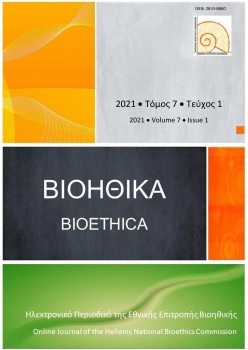Η ανίχνευση του ψεύδους στον εγκέφαλο - Ηθικές, κοινωνικές, νομικές και θρησκευτικές προκλήσεις

Περίληψη
Η ανίχνευση - αναγνώριση του ψεύδους αποτελεί διακαή πόθο του ανθρώπου από αρχαιοτάτων χρόνων. Με τους αιώνες, διαφορετικές μέθοδοι έχουν επινοηθεί για την ανίχνευση της εξαπάτησης. Μερικές είναι χαμηλής τεχνολογίας, όπως η εξειδικευμένη αναγνώριση των εκφράσεων του προσώπου, ενώ άλλες υψηλότερης τεχνολογίας, με μέσα και μηχανήματα, όπως ο επονομαζόμενος πολυγράφος ή «ανιχνευτής ψεύδους», μια συσκευή που σχεδιάστηκε στις αρχές του 20ου αιώνα για να εντοπίζει φυσιολογικές αλλαγές του ανθρώπινου οργανισμού, κυρίως μέσω καταγραφής της αύξησης της εφίδρωσης, του καρδιακού παλμού και της αρτηριακής πίεσης, με σκοπό την αναγνώριση του ψεύδους και εφαρμογή σε τομείς όπως, η δικαιοσύνη, ο στρατός και οι μυστικές υπηρεσίες.
Πρόσφατες προσπάθειες για την ανίχνευση του ψεύδους επικεντρώθηκαν σε μετρήσεις της εγκεφαλικής δραστηριότητας. Η προσέγγιση αυτή, σε αντίθεση με τις προηγούμενες μεθόδους που ανίχνευαν τη συναισθηματική διέγερση, ανιχνεύει φυσιολογικές αλλαγές που σχετίζονται με γνωστικές διαδικασίες κατά τη διάρκεια της εξαπάτησης και επομένως, σύμφωνα με τους υπέρμαχους της τεχνικής, θα μπορούσε, κατ’ αρχήν, να ανιχνεύσει τη διαδικασία της ίδιας της εξαπάτησης. Την πιο γνωστή μέθοδο για τον εντοπισμό μιας «νευροφυσιολογικής διαφοράς μεταξύ εξαπάτησης και αλήθειας» στον εγκέφαλο αποτελεί η Λειτουργική Απεικόνιση Μαγνητικού Συντονισμού (ΛΑΜΣ) (functional Magnetic Resonance Imaging f-MRI), μια μαγνητική αποτύπωση, ουσιαστικά, του εγκεφάλου που δείχνει ότι, η εξαπάτηση βρίσκεται στον προμετωπιαίο φλοιό, ακριβώς πίσω από το μέτωπο.
Ωστόσο, αυτές οι προσεγγίσεις «χαρτογράφησης» του εγκεφάλου, πόσο ακριβείς και αξιόπιστες είναι για την εξαγωγή ασφαλών συμπερασμάτων σχετικά με την ανίχνευση του ψεύδους; Ποιες οι ηθικές, νομικές, θρησκευτικές και επιστημονικές προεκτάσεις του ζητήματος από την «εισβολή» των επονομαζόμενων νεύρο-επιστημών για την αναγνώριση του ψεύδους σε προσωπικά δεδομένα, ατομικές ελευθερίες, στο δικαίωμα της σιωπής και μη αυτοενοχοποίησης και στην «ελευθέρα βούληση» του ανθρώπου;
Κρίσιμα ερωτήματα, που εξετάζονται στην παρούσα εργασία, σε μια προσπάθεια προσέγγισης της ανίχνευσης του ψεύδους στον εγκέφαλο και των προκλήσεων - προβληματισμών επί του ζητήματος που δύναται να καθορίσει μελλοντικά τον τρόπο που αντιλαμβανόμαστε την ανθρώπινη κοινωνίαΛεπτομέρειες άρθρου
- Πώς να δημιουργήσετε Αναφορές
-
Poulou, C. G. (2021). Η ανίχνευση του ψεύδους στον εγκέφαλο - Ηθικές, κοινωνικές, νομικές και θρησκευτικές προκλήσεις. Βιοηθικά, 7(1), 72–85. https://doi.org/10.12681/bioeth.26539
- Ενότητα
- Ανασκοπήσεις

Αυτή η εργασία είναι αδειοδοτημένη υπό το CC Αναφορά Δημιουργού 4.0.
Οι Συγγραφείς που δημοσιεύουν εργασίες τους σε αυτό το περιοδικό συμφωνούν στους παρακάτω όρους:
- Οι Συγγραφείς διατηρούν τα Πνευματικά Δικαιώματα και χορηγούν στο περιοδικό το δικαίωμα της πρώτης δημοσίευσης, ενώ ταυτόχρονα τα πνευματικά δικαιώματα της εργασίας προστατεύονται σύμφωνα με την Creative Commons Attribution CC BY 4.0, που επιτρέπει άμεση πρόσβαση στις εργασίες και κάθε χρήστη να διαβάζει, να κάνει λήψη, να αντιγράφει, να διανέμει, να εκτυπώνει, να αναζητά, ή να συνδέει με το πλήρες περιεχόμενο των άρθρων, να τα αναζητά για ευρετηρίαση, να τα χρησιμοποιεί ως δεδομένα σε λογισμικό, ή να τα χρησιμοποιεί για οποιοδήποτε άλλο νόμιμο σκοπό. Προϋπόθεση ε΄ιναι η αναφορά στον αρχικό δημιουργό/ούς και την αρχική δημοσίευση σε αυτό το περιοδικό.
- Οι Συγγραφείς μπορούν να συνάπτουν ξεχωριστές, και πρόσθετες συμβάσεις και συμφωνίες για την μη αποκλειστική διανομή της εργασίας όπως δημοσιεύτηκε στο περιοδικό αυτό (π.χ. κατάθεση σε ένα ακαδημαϊκό καταθετήριο ή δημοσίευση σε ένα βιβλίο), με την προϋπόθεση της αναγνώρισης και την αναφοράς της πρώτης δημοσίευσης σε αυτό το περιοδικό.
Το περιοδικό Βιοηθικά επιτρέπει και ενθαρρύνει τους συγγραφείς να καταθέτουν τα δημοσιευμένα άρθρα σε θεσμικά (π.χ. το αποθετήριο του Εθνικού Κέντρου Τεκμηρίωσης) ή θεματικά αποθετήρια (π.χ. αποθετήριο SSOAR για τις Κοινωνικές Επιστήμες), μετά τη δημοσίευσή τους στο περιοδικό «Βιοηθικά» και με όρους Ανοικτής Πρόσβασης, όπως κατά περίπτωση προσδιορίζονται από τους χρηματοδότες της έρευνάς τους ή/και τα ιδρύματα με τα οποία συνεργάζονται.
Κατά την κατάθεση της εργασίας τους, οι συγγραφείς πρέπει να παρέχουν πληροφορίες σχετικά με τη δημοσίευση του άρθρου στο περιοδικό «Βιοηθικά» και τις πηγές χρηματοδότησης της έρευνάς τους.
Κατάλογοι των ιδρυματικών και θεματικών αποθετηρίων ανά χώρα υπάρχουν στη βάση http://opendoar.org/countrylist.php . Οι συγγραφείς έχουν τη δυνατότητα να καταθέσουν χωρίς κόστος την εργασία τους στο αποθετήριο www.zenodo.org, το οποίο υποστηρίζεται από το OpenAIRE (www.openaire.eu ), στο πλαίσιο των πολιτικών της Ευρωπαϊκής Επιτροπής για την ενίσχυση της Ανοικτής ακαδημαϊκής έρευνας.


